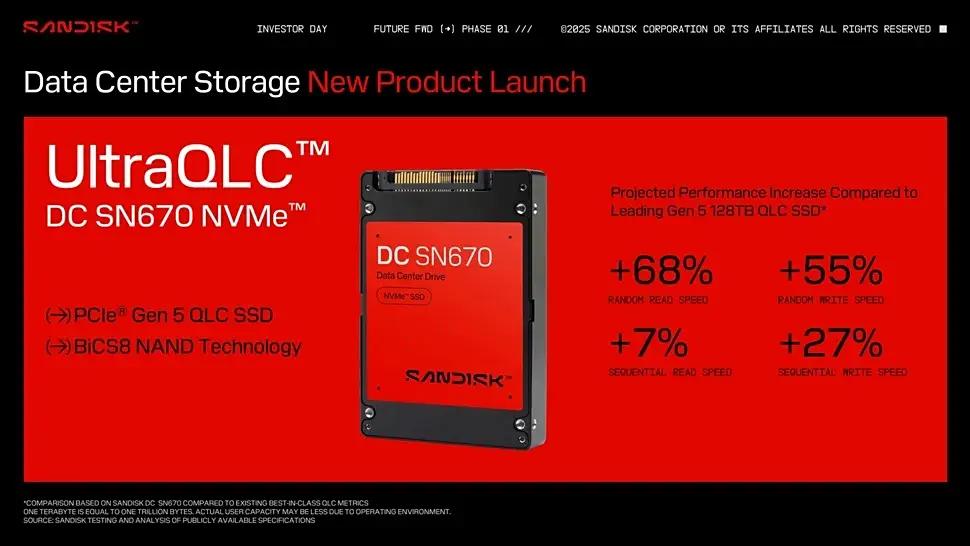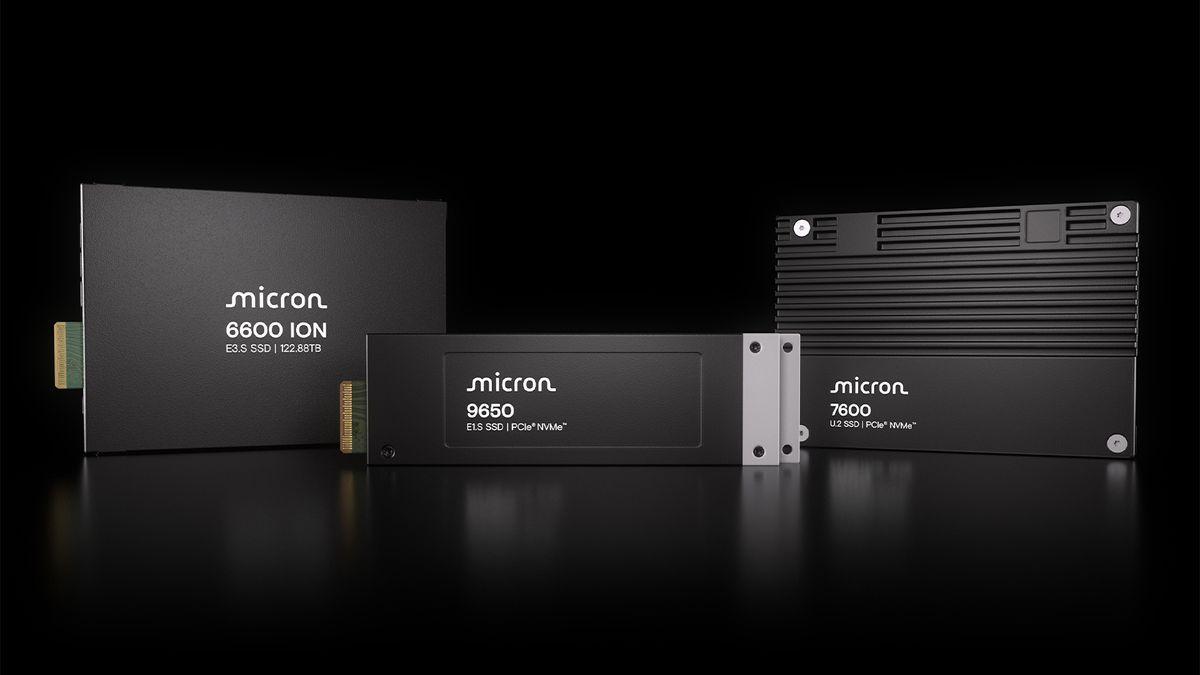SanDisk Unveils Groundbreaking 256TB SSD for AI and Hyperscale Infrastructure
3 Sources
3 Sources
[1]
Sandisk's 256TB AI drive breaks records, stuns engineers, and leaves performance questions hanging in the background
Direct Write QLC may sacrifice speed in exchange for higher reliability and data integrity Sandisk has announced a 256TB SSD, the UltraQLC SN670, which is set to ship in the first half of 2026. This model represents the largest SSD ever revealed by the company, marking a bold step toward high-density storage solutions tailored for AI and hyperscale infrastructure. Although the company plans to release the 128TB version to testers within weeks, full commercial availability remains months away. At its core, the SN670 is built on a 218-layer BiCS 3D NAND architecture and features a CBA (CMOS directly Bonded to Array) 2Tb die. It connects through a PCIe Gen5 NVMe interface and is part of Sandisk's new UltraQLC platform. Unlike conventional SSDs that buffer data through pseudo-SLC caches, this model uses a "Direct Write QLC" approach. This simplifies the writing process and makes the drive more power-loss safe, but it also introduces tradeoffs, especially when it comes to performance under heavy or short-burst loads. Without an SLC cache, the SN670 may suffer from slower short-burst writes, inconsistent performance under load, and increased controller demands, making it less responsive during intensive or unpredictable workloads. However, Sandisk claims the SN670 delivers over 68% faster random reads and 55% faster random writes compared to a leading 128 TB Gen 5 QLC SSD. The sequential read speeds are over 7% better, while sequential write speeds improve by more than 27% in internal comparisons. Sandisk has emphasized benefits like Dynamic Frequency Scaling, which is said to improve performance by up to 10 percent at the same power level It also claims the Data Retention profile could reduce recycling wear by as much as 33%. Both features are intended to enhance longevity and reduce energy consumption. However, none of these claims are backed by disclosed performance data such as read/write speeds or endurance figures. Internally, the UltraQLC SN670 is supported by a custom controller and firmware, which Sandisk says enables better latency and bandwidth, but without actual benchmarks or IOPS comparisons, these statements remain marketing-driven projections. It is worth noting earlier iterations of Sandisk's enterprise drives using QLC NAND showed limitations compared to TLC-based models. In this case, native QLC programming latencies could reach 800-1200 microseconds, several times slower than SLC-based designs. Sandisk may be relying on optimizations like large DRAM buffers or advanced die parallelism, but such architectural details have yet to be confirmed. The final product will arrive in U.2 form initially, with more variants expected later in 2026. For now, Sandisk's 256TB drive is a symbolic leap toward future data infrastructure, not a realistic option for mainstream users.
[2]
SanDisk 256TB UltraQLC NVMe SSD: Specs & 2026 Shipping Date
SanDisk has rolled out a brand-new UltraQLC NVMe SSD that packs an impressive 256 TB of storage capacity into a standard U.2 form factor. The drive is built on a custom platform that includes a multi-core controller, unique firmware, and high-density 2 Tb BiCS8 3D QLC NAND chips. If you need slightly less space, there's also a 128 TB version. Both models are expected to start shipping sometime in the first half of 2026. What makes this SSD stand out for AI applications and large-scale cloud systems is the way it handles data writes. Instead of using a pseudo-SLC cache to stage writes, the controller writes directly to QLC cells. That cuts out an extra step, which lowers write latency and simplifies the drive's internal architecture. SanDisk has also added a dynamic frequency scaling feature that automatically tweaks the controller's operating frequency; they say this can boost performance by around 10 percent, even at lower power levels. On the reliability side, the drive includes a specialized data-retention optimization profile. Essentially, the controller reduces how often it needs to refresh stored data, dropping those refresh cycles by roughly a third. This not only improves energy efficiency but also helps maintain data integrity over time. Even though we know the capacity and these headline features, a few details are still pending. SanDisk plans to share full performance numbers, endurance ratings and power-consumption figures later this year. For now, customers in hyperscale cloud environments and AI service providers can look forward to next-generation storage with densities that were hard to imagine a few years ago. All told, the 256 TB UltraQLC NVMe SSD targets organizations that need both massive capacity and efficient data handling. Its direct QLC write capability, adaptive frequency scaling and retention-profile optimizations make it a strong contender for workloads involving large datasets and AI inference or training tasks. Keep an eye out for the detailed specs and benchmarks slated to appear before the product ships in early 2026.
[3]
SanDisk Showcases 256TB Enterprise NVMe SSD Built on UltraQLC Platform at FMS 2025
As workloads and business requirements evolve in the AI era, flash storage must become more customizable to match complex workloads. The new SANDISK® 256TB1 NVMeTM SSD, built on the UltraQLCTM platform, is designed for AI-driven, data-intensive workloads like data ingest, preparation, and fast AI data lakes with high-performance speeds and power efficiency, while improving TCO for high-capacity applications in hyperscale cloud. "As we move into the next phase of the AI era, flash storage is becoming a critical enabler of intelligent, high-performance workloads," said Khurram Ismail, Chief Product Officer at Sandisk. "Our UltraQLCplatform is the culmination of years of work and learnings to build a flexible and robust architecture that achieves extraordinary capacities and maximum performance while maintaining efficiency. This enables us to further expand our portfolio to meet AI demands at scale and helps our customers move faster, process more and turn data into real innovation."
Share
Share
Copy Link
SanDisk has announced a massive 256TB SSD, the UltraQLC SN670, designed for AI workloads and hyperscale infrastructure. Set to ship in 2026, this drive introduces innovative features and raises questions about performance trade-offs.
SanDisk's Breakthrough 256TB SSD
SanDisk has unveiled its largest solid-state drive (SSD) to date, the UltraQLC SN670, boasting an unprecedented 256TB capacity. This groundbreaking storage solution is specifically designed for AI workloads and hyperscale infrastructure, marking a significant leap in high-density storage technology
1
2
.
Source: DT
Technical Specifications and Architecture
The SN670 is built on a 218-layer BiCS 3D NAND architecture and features a CBA (CMOS directly Bonded to Array) 2Tb die. It connects through a PCIe Gen5 NVMe interface and is part of SanDisk's new UltraQLC platform
1
. The drive utilizes high-density 2 Tb BiCS8 3D QLC NAND chips and a custom multi-core controller with unique firmware2
.Innovative "Direct Write QLC" Approach
Unlike conventional SSDs that use pseudo-SLC caches for data buffering, the SN670 employs a "Direct Write QLC" approach. This method simplifies the writing process and enhances power-loss safety. However, it may introduce performance trade-offs, particularly for heavy or short-burst loads
1
2
.Performance Claims and Uncertainties
SanDisk claims the SN670 delivers over 68% faster random reads and 55% faster random writes compared to a leading 128 TB Gen 5 QLC SSD. Sequential read speeds are said to be 7% better, while sequential write speeds improve by more than 27% in internal comparisons
1
. However, these claims are not yet backed by disclosed performance data or benchmarks.Advanced Features for AI and Hyperscale Applications
The drive incorporates several advanced features aimed at enhancing performance and efficiency:
- Dynamic Frequency Scaling: This feature is said to improve performance by up to 10% at the same power level
1
2
. - Data Retention Profile: Claimed to reduce recycling wear by as much as 33%, potentially enhancing longevity and reducing energy consumption
1
3
. - Customizable Flash Storage: Designed to match complex workloads in the AI era, particularly for data ingest, preparation, and fast AI data lakes
3
.
Related Stories
Availability and Future Prospects

Source: Guru3D
The 256TB UltraQLC SN670 is scheduled to ship in the first half of 2026, with a 128TB version expected to be available to testers within weeks
1
2
. The product will initially arrive in U.2 form factor, with more variants anticipated later in 20261
.Implications for AI and Data Infrastructure
This massive-capacity SSD represents a symbolic leap toward future data infrastructure, particularly for organizations dealing with large datasets and AI inference or training tasks. Its direct QLC write capability, adaptive frequency scaling, and retention-profile optimizations make it a strong contender for AI-driven, data-intensive workloads
2
3
.As the AI era progresses, flash storage is becoming increasingly critical for intelligent, high-performance workloads. The UltraQLC platform's development reflects years of work to create a flexible and robust architecture that achieves extraordinary capacities while maintaining efficiency
3
.References
Summarized by
Navi
[1]
Related Stories
Recent Highlights
1
OpenAI releases GPT-5.2 AI model after code red memo signals Google Gemini 3 threat
Technology

2
Disney invests $1 billion in OpenAI, licenses 200+ characters for Sora AI video generator
Technology

3
OpenAI faces wrongful death lawsuit after ChatGPT allegedly fueled murder-suicide tragedy
Policy and Regulation








